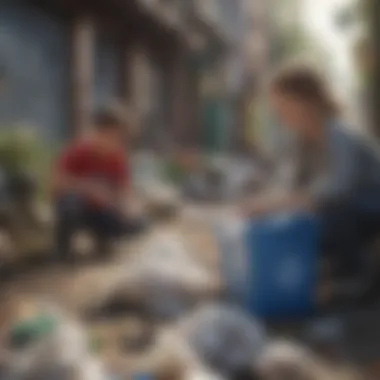Empowering Children Through Community Trash Cleanup for Environmental Education


Nature Topic Overview
In today's fast-paced world, instilling values of environmental consciousness and community engagement in children is a crucial endeavor.
Introduction
Understanding the Importance of Environmental Education
Impacting Children's Awareness
One of the fundamental aspects of environmental education is impacting children's awareness about the fragility of our ecosystems. Through hands-on experiences like neighborhood trash cleanups, kids witness firsthand the consequences of pollution and waste mismanagement. Such awareness fosters a deeper understanding of the interconnectivity between human actions and environmental health, planting the seeds for responsible decision-making in the future. This section explores how highlighting the detrimental effects of environmental negligence can spur children to become proactive agents of change.
Promoting Sustainable Behaviors
Promoting sustainable behaviors among children is crucial for fostering a culture of eco-consciousness. By showcasing how simple actions like proper waste disposal and recycling can make a significant impact, we instill sustainable practices early on. Through interactive sessions and practical examples during cleanup events, kids learn the value of reducing, reusing, and recycling, equipping them with lifelong skills to minimize their ecological footprint. This segment delves into strategies for nurturing eco-friendly habits that can be seamlessly integrated into children's daily routines.
Fostering Environmental Stewardship
Fostering environmental stewardship instills a sense of guardianship towards nature and its resources. Encouraging children to take ownership of their environment empowers them to protect and preserve it for future generations. By nurturing a mindset of responsibility and respect towards nature, we cultivate a generation of environmental advocates and guardians. This part delves into how instilling a sense of stewardship can transform passive observers into active participants in environmental conservation efforts.
Key Benefits of Neighborhood Trash Cleanup
Educational Value
The educational value derived from participating in neighborhood trash cleanups extends beyond traditional classroom settings. Children engage in experiential learning, where they observe ecological concepts in practice and comprehend the tangible effects of human activities on the environment. By connecting theoretical knowledge with real-world scenarios, kids develop a profound understanding of environmental issues, nurturing a sense of intellectual curiosity and environmental literacy. This section explores how hands-on experiences in cleanup initiatives serve as effective educational tools that transcend textbook learning.
Community Engagement
Community engagement lies at the heart of neighborhood cleanup activities, fostering unity and collective action towards a common cause. By engaging children in collaborative cleanup efforts, we cultivate a sense of belonging and social responsibility within the community. Children learn the value of working together towards a shared goal, fostering relationships and a sense of camaraderie that transcend generational gaps. This segment delves into the social intricacies of community engagement during cleanup events and its long-term impact on fostering social cohesion.
Environmental Impact


The environmental impact of neighborhood trash cleanups reverberates beyond immediate cleanliness to tangible ecological benefits. Children witness the transformative power of collective action in restoring and preserving natural habitats. By quantifying the amount of waste collected and discussing its implications on local ecosystems, kids grasp the tangible results of their efforts. This part explores the ripple effects of children's contributions to environmental sustainability through direct action, emphasizing the role of cleanup initiatives in promoting a cleaner and greener environment.
Preparing for the Cleanup
When diving into the profound realm of preparing for the essential activity of neighborhood trash cleanup, we uncover a plethora of pivotal elements that shape the foundation of this operation. One must not underestimate the significance of meticulous planning, safety considerations, and efficient supply coordination when orchestrating such an endeavor. Each facet plays a crucial role in ensuring the efficacy and success of the cleanup initiative. By delving into the preparatory phase with a strategic mindset, we pave the way for a seamless execution and a transformative experience for all involved.
Organizational Steps
Planning Logistics
Planning logistics stands at the forefront of the preparatory phase, setting the stage for a well-coordinated and streamlined cleanup process. The intricacies of planning logistics entail mapping out the cleanup area, establishing roles and responsibilities, and creating a timeline for the event. This systematic approach not only enhances efficiency but also fosters a sense of organization and purpose among participants. The structured nature of planning logistics binds all elements of the cleanup together, ensuring a cohesive and impactful community effort.
Safety Considerations
Safety considerations serve as a non-negotiable aspect of preparing for a neighborhood trash cleanup. Prioritizing the well-being of all participants, especially children, is paramount in fostering a secure environment for the activity. From ensuring the presence of first-aid kits to educating volunteers on proper waste handling techniques, safety considerations lay the groundwork for a successful and risk-free cleanup event. By proactively addressing potential hazards and implementing safety protocols, organizers demonstrate their commitment to creating a safe space for all involved.
Supply Coordination
Supply coordination emerges as a critical component in the preparation phase, guaranteeing that all necessary resources are readily available for the cleanup. Securing equipment such as gloves, bags, and trash pickers, and ensuring an adequate supply of refreshments for volunteers, exemplifies the meticulous coordination required for a smooth-sailing cleanup operation. Effective supply coordination not only enhances the efficiency of the event but also demonstrates forethought and thorough planning on the part of the organizers. By meticulously managing the logistics of supplies, organizers can facilitate a seamless and rewarding experience for all participants.
Engagement Strategies for Children
Engaging children through thoughtful strategies is pivotal in developing their consciousness about environmental responsibility. In this insightful section, we delve into the significance of involving children actively in neighborhood cleanup efforts. By immersing children in hands-on activities, we aim to kindle their awareness of sustainable practices. This approach fosters a deep-rooted connection with the environment from a tender age, nurturing a sense of responsibility and care. By emphasizing engagement strategies tailored to children's needs, we create a lasting impact on their eco-consciousness.
Interactive Learning Activities
Trash Sorting Challenges
The Trash Sorting Challenges provide a dynamic means to educate children on waste segregation. Through this activity, kids learn firsthand the importance of sorting recyclables from regular waste. This hands-on experience instills in them the significance of proper waste management and its positive environmental impact. By engaging in Trash Sorting Challenges, children not only enhance their cognitive abilities but also develop a sense of fulfillment by actively participating in the preservation of their surroundings.
Nature Scavenger Hunt
Embarking on a Nature Scavenger Hunt allows children to explore the natural world while learning about local ecosystems. This interactive activity encourages kids to observe, appreciate, and connect with the environment around them. By engaging in a Nature Scavenger Hunt, children develop a profound sense of curiosity and respect for nature. This hands-on experience fosters a deeper understanding of biodiversity and the interconnectedness of all living beings.


Environmental Quiz
The Environmental Quiz serves as an engaging medium to test children's knowledge and comprehension of environmental concepts. By participating in this quiz, kids can consolidate the information they have learned during the cleanup initiative. This activity not only reinforces environmental education but also encourages critical thinking and problem-solving skills in children. The Environmental Quiz promotes a fun and interactive way for children to assess their understanding of sustainability and environmental stewardship.
Artistic Expression Opportunities
Trash Art Creation
The creation of art from collected trash materials offers a unique avenue for children to express their creativity while promoting environmental consciousness. Through Trash Art Creation, kids transform discarded items into meaningful artworks, highlighting the importance of recycling and upcycling. This activity sparks imagination and innovation in children, fostering a sense of beauty in sustainability. By engaging in Trash Art Creation, children learn to value resources and see the potential for beauty in overlooked materials.
Eco-Friendly Crafts
Eco-Friendly Crafts introduce children to sustainable practices through creative hands-on projects. By using recyclable and eco-conscious materials, kids can craft items that promote a greener lifestyle. This activity not only enhances children's artistic skills but also educates them on the importance of reducing waste and reusing materials. Eco-Friendly Crafts empower children to make environmentally friendly choices in their daily lives, instilling a sense of resourcefulness and environmental responsibility.
Mural Painting
The collaborative effort of Mural Painting enables children to visually depict their commitment to environmental stewardship. By working together to create a mural that showcases nature and sustainability themes, kids learn the value of teamwork and collective action. Mural Painting instills a sense of pride and ownership in children as they contribute to beautifying their community through art. This activity reinforces the message of unity in environmental conservation, inspiring children to be advocates for a cleaner, healthier planet.
The Cleanup Event
In the realm of community engagement and environmental education, the serves as a pivotal moment that embodies the essence of hands-on experience and civic responsibility. This segment delves into the structural aspects and inherent significance of orchestrating a holistic cleanup initiative within a local precinct. From fostering camaraderie to imbuing a sense of environmental stewardship, the Cleanup Event encapsulates a multifaceted approach towards nurturing sustainable practices in children. Amidst the conscientious efforts of coordinators and the enthusiastic participation of young volunteers, the Cleanup Event symbolizes a paramount occasion transforming theoretical concepts into tangible actions that reverberate within the community.
Hands-On Experience
Collecting and Sorting Waste
A critical juncture within the Cleanup Event, emerges as a cornerstone activity that underscores the meticulous nature of environmental conservation. This segment is earmarked by the meticulous scrutiny of discarded items, emphasizing the importance of waste segregation and proper disposal methods. By engaging children in the systematic classification of waste materials, this process not only heightens environmental awareness but also cultivates a sense of responsibility towards waste management. bridges the gap between theoretical knowledge and practical application, empowering young participants to make informed decisions that positively impact their surroundings through sustainable practices.
Team Collaboration
Integral to the essence of communal effort, epitomizes the synergy achieved through collective action during the Cleanup Event. This facet underscores the significance of teamwork, communication, and coordination among participants to ensure the seamless execution of cleanup activities. By fostering a spirit of unity and cooperation, instills valuable interpersonal skills in children while reinforcing the concept of shared responsibility towards environmental preservation. Through collaborative endeavors, young individuals not only contribute to a cleaner environment but also develop a profound appreciation for the power of collective engagement in fostering positive change.
Environmental Impact Discussion


A substantive component woven into the fabric of the Cleanup Event is , a forum designed to facilitate reflective dialogue on the broader ramifications of environmental degradation. This segment prompts participants to contemplate the cumulative effects of waste mismanagement on ecosystems and communities, instigating a deeper comprehension of environmental interdependencies. By delving into the repercussions of unsustainable practices, cultivates a consciousness of ecological fragility and the imperative for conscious consumption. Through meaningful discourse, children are equipped with the knowledge and perspective necessary to become stewards of sustainable development, steering towards a greener and healthier future.
Community Bonding
Within the rich tapestry of communal solidarity, emerges as a tapestry interwoven with threads of shared experiences and mutual camaraderie. This segment accentuates the transformative power of interpersonal connections forged amidst the collaborative spirit of the Cleanup Event. Through fostering authentic connections and nurturing a sense of belonging, establishes a supportive ecosystem that extends beyond the realms of environmental advocacy, engendering enduring relationships that bolster the ethos of community welfare and environmental stewardship.
Networking Opportunities
Encompassing diverse communication channels and collaborative platforms, serve as a pathway for participants to engagewith local stakeholders, environmental organizations, and like-minded individuals sharing the vision of a cleaner, greener future.
Reflection and Follow-Up Actions
Post-Cleanup Reflection
Impact Assessment:
The Impact Assessment component within the post-cleanup reflection serves as a pillar of evaluation, quantifying the tangible outcomes of the children's efforts. By scrutinizing the collected data and observing the immediate effects on the environment and community, stakeholders can gauge the initiative's efficacy. This method aids in measuring the environmental impact and educational advances garnered from the cleanup activity, enabling informed decision-making for future endeavors. Despite its meticulous nature, Impact Assessment provides invaluable insights for refining strategies and enhancing overall program effectiveness.
Lessons Learned:
Discussing the segment of Lessons Learned encapsulates the invaluable takeaways derived from the cleanup experience. It sheds light on the practical insights acquired by children, parents, and organizers throughout the event. By reflecting on challenges faced, successful practices, and areas for improvement, participants can internalize key teachings and leverage them for personal and collective growth. Lessons Learned not only enrich individuals with experiential knowledge but also pave the way for iterative enhancements in subsequent initiatives, fostering a culture of continuous learning and refinement.
Future Plans:
The Future Plans segment delineates the roadmap for sustaining momentum and building upon the success of past initiatives. By outlining strategic objectives, resource allocations, and long-term goals, this aspect injects vision and ambition into the initiative. Future Plans serve as a catalyst for innovation, expansion, and deeper community engagement. Through proactive planning and foresight, stakeholders can ensure the perpetuity of environmental efforts and leave a lasting legacy of stewardship for future generations.
Continued Environmental Advocacy
Maintaining Clean Practices:
In examining Maintaining Clean Practices, we confront the enduring commitment required to uphold environmental sanctity beyond the cleanup event. This aspect emphasizes the cultivation of daily habits and routines that promote cleanliness, waste reduction, and sustainability. By integrating clean practices into everyday life, individuals can translate the ephemeral impact of a single cleanup into a sustainable lifestyle choice, fostering a culture of conscientious environmental stewardship.
Supporting Green Initiatives:
Delving into Supporting Green Initiatives unveils the strategic backing provided to broader environmental causes and initiatives beyond local cleanups. This component underscores the interconnectedness of environmental endeavors and the importance of collective action in driving systemic change. By advocating for and contributing to green projects, participants extend their impact footprint and align with global sustainability goals, amplifying the ripple effect of their localized efforts.
Spreading Awareness:
Exploring the facet of Spreading Awareness reveals the transformative power of knowledge dissemination in catalyzing societal change. By raising awareness about environmental issues, sustainable practices, and the significance of community involvement, stakeholders can amplify the impact of their advocacy efforts. Spreading Awareness not only educates and empowers individuals but also mobilizes a network of like-minded champions, spearheading a movement towards a more conscious and eco-friendly society.







